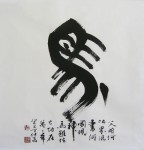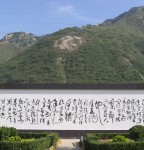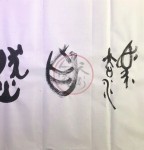An 11th-century calligraphy scroll has set a record for a Chinese work of art — more than doubling the previous high price set at auction late last year.
The scroll, 11m (36ft) long, by Huang Tingjian — one of China’s most famous and influential calligraphers — was sold for 438 million yuan (£44 million) by Poly International Auction in Beijing.
The anonymous buyer made the bid by telephone.
The price compares with a 16th century Ming dynasty paintingEighteen Arhats by Wu Bin which sold for 169 million yuan.
Prior to that, a Yuan dynasty (1279-1368) blue and white porcelain vase sold at Christie’s in London in 2005 for £15 million, and was at the time the most valuable piece of Chinese art.
China’s new generation of self-made millionaires — entrepreneurs who have made their fortunes during the boom years — are increasingly eager to build art collections.
They are doing this as an investment, to bring back treasures lost to foreign collectors in the last century and to contribute to a cultural revival.
Classical art, particularly porcelain, has set a series of recent records with the country’s new-rich seeing this as a safer investment than contemporary art.
The Huang scroll is believed to have been painted in around 1095, and is a copy of a 600-word piece of prose writing by Wei Zheng, a famed chancellor of the Tang dynasty, who lived from 580 to 643.
It is extremely rare for such early works to find their way onto the market since most are now in museums.
Even more unusual is for a piece by a calligrapher — regarded as one of the four greatest of his generation, and who created a new style of his own — to go under the hammer.
William Hanbury-Tenison, a British fine art agent, said of the record price: “This shows that calligraphy is the key Asian art form. Calligraphy doesn’t just represent the thoughts of the artist but their physical methods in wielding a brush.”
Huang was regarded as a master for the size and spacing of his characters as well as for a style that was very fluid.
Previous calligraphers had generally kept to recognised styles, keeping their characters in regular shapes. But Huang broke from that tradition with brush strokes that flow, almost with a flourish, out of an informal square as if escaping from a cage.
Mr Hanbury-Tenison said: “In Western art everything begins with Greek sculpture, in Asian art with Chinese calligraphy. Huang Jingtian’s calligraphy can be compared with the sculpture of Praxiteles.”
The fourth century BC sculptor was the first to represent the nude female form in a life-size statue.
| < Prev | Next > |
|---|
- 2011-04-09 - Anniversary of Seal Script Character “水” in Zhongtiao Mountain by Chinese Calligrapher Ding Shimei
- 2010-12-03 - Chinese Calligraphy and It's Expression
- 2010-11-06 - 羲之真迹难觅,诸皇尊王,高古摹本亦珍, 一字千金
- 2010-07-29 - 山西陶寺扁壶毛笔朱书,将中国文字史向前推进800年
- 2010-07-24 - 天人书法网改版升级了,欢迎大家访问!
- 2010-06-26 - Chinese modern artist Wu Guanzhong dies
- 2010-05-24 - Traditional Chinese Calligraphy tools for world heritage list
- 2010-05-18 - Chinese Calligraphy: The Typical Sign of Chinese Culture
- 2010-04-14 - 陈洪武:什么是当代书法的精气神
- 2010-04-08 - 屏蔽英文缩略词,涉嫌“广电锁国”














